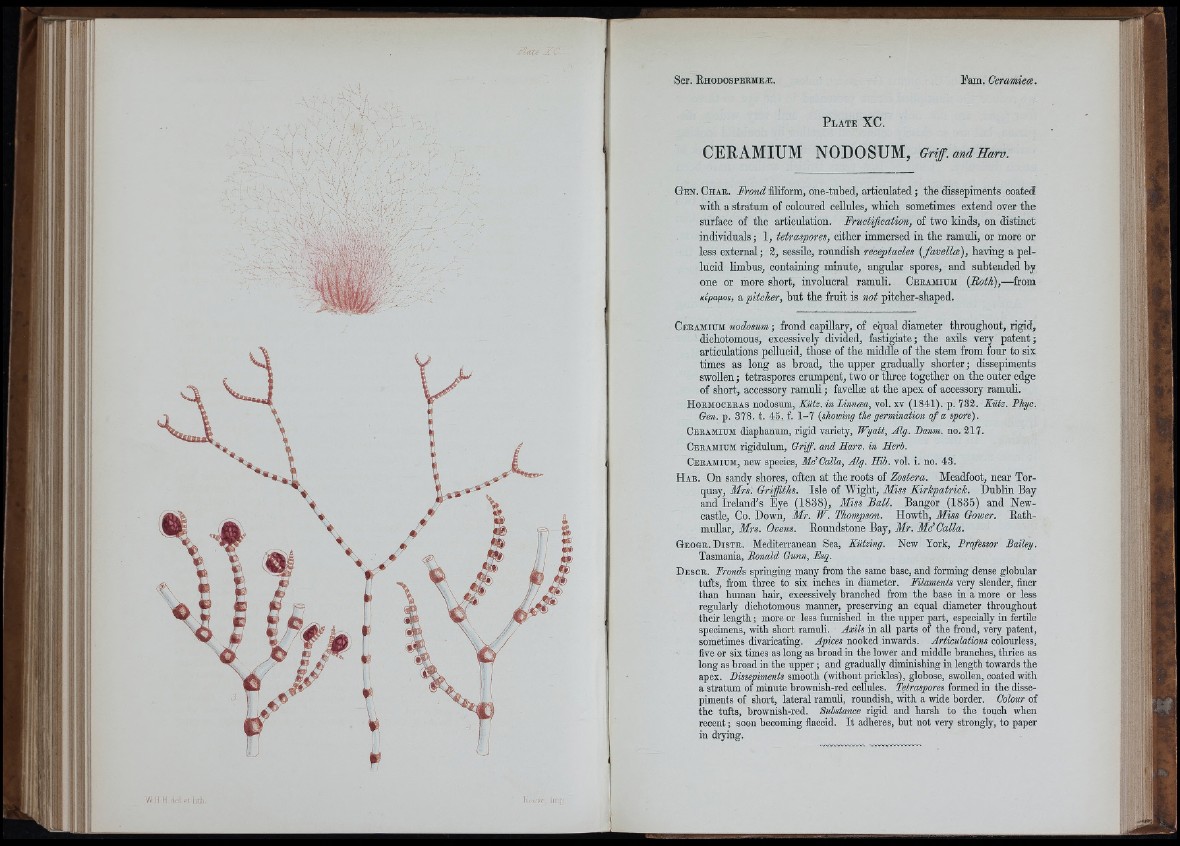
■ 'V--:
■ ■ A "H ;• ; 'i' ■ .V ,
■ . '-r.- ■ ; \ ;/ •/./, ' ; . /
' ■■ 4 toto •.i-'/' 4 /
■ . ■■Vs/V i
- y x - < X f N : y i é / i X H
. X. i f f f i X X é ñ X X ' y ’
W [1 II ,1,.¡ ,1 liij,.
P l a t e XC.
CERAMIUM NODOSUM, Griff, andHarv.
G e n . C h a e . Frond filiform, one-tubed, articulated ; the dissepiments coated
with a stratum of coloured cellules, which sometimes extend over the
surface of the articulation. Fructification, of two kinds, en distinct
individuals ; 1, tetraspores, either immersed in the ramuli, or more or
less external ; 2, sessüe, roundish receptacles (favella:'), having a pellucid
limbus, containing minute, angrdar spores, and subtended by
one or more short, involucral ramuli. C e e a m i u m (Roth),—from
KÎpapos, a pitcher, but the fruit is not pitcher-shaped.
C e r a m i u m nodosum ; frond capillary, of equal diameter throughout, rigid,
diohotomous, excessively divided, fastigiate; the axüs very patent;
articulations peUucid, those of the middle of the stem from four to six
times as long as broad, the upper graduaUy shorter ; dissepiments
swoUeu ; tetraspores erumpent, two or three together ou the outer edge
of short, accessory ramuh ; faveUæ at the apex of accessory ramuli.
H o rm o c e ea s nodosum, Kiitz. in Linnaa, vol. xv (1841). p. 732. Kiitz. Phyc.
Gm. p. 378. t. 45. f. 1-7 (showing the germination o f a spore).
Ce r am iu m d ia p h an um , r ig id v a rie ty , Wyatt, Alg. Lanm. n o . 2 1 7 .
Ce r a m iu m rigidulum, Griff, and H a n . in Herb.
Ce r a m iu m , new species, Mc’Calla, Alg. Hib. vol. i. no. 43.
H a b . On sandy shores, often at the roots of Zostera. Meadfoot, near Torquay,
Mrs. Griffiths. Isle of Wight, Miss Kirkpatrick. Dublin Bay
and Ireland’s Eye (1838), Miss Ball. Bangor (1835) and Newcastle,
Co. Down, Mr. W. Thompson. Howth, Miss Gower. Eath-
mullar, Mrs. Ovens. Eoundstone Bay, Mr. Mc’Calla.
G e o o e . D i s t r . Mediterranean Sea, Kiitzing. New York, Professor Bailey.
Tasmania, Ronald Gunn, Esq.
D e s o e . Eronds springing many from the same base, and forming dense globular
tufts, from three to six inches in diameter. Eilaments very slender, finer
than human hair, excessively branched from the base in a more or less
regularly dichotomous manner, preserving an equal diameter throughout
their length ; more or less furnished in the upper part, especially in fertile
specimens, with short ramuli. Axils in aU parts of the frond, very patent,
sometimes divaricating. Apices nooked inwards. Articulations colourless,
five or six times as long as broad in the lower and middle branches, thrice as
long as broad in the upper ; and graduaUy diminishing in length towards the
apex. Dissepiments smooth (without prickles), globose, swoUen, coated with
a stratum of minute brownish-red oeUules. Tetraspores formed in the dissepiments
of short, lateral ramuU, roundish, with a wide border. Colour of
the tufts, brownish-red. Substance rigid and harsh to the touch when
recent ; soon becoming flaccid. I t adheres, but not very strongly, to paper
in drying.